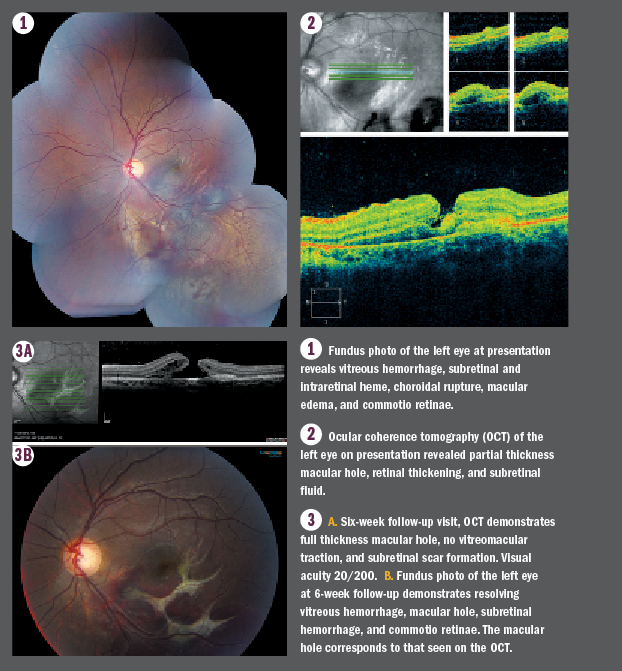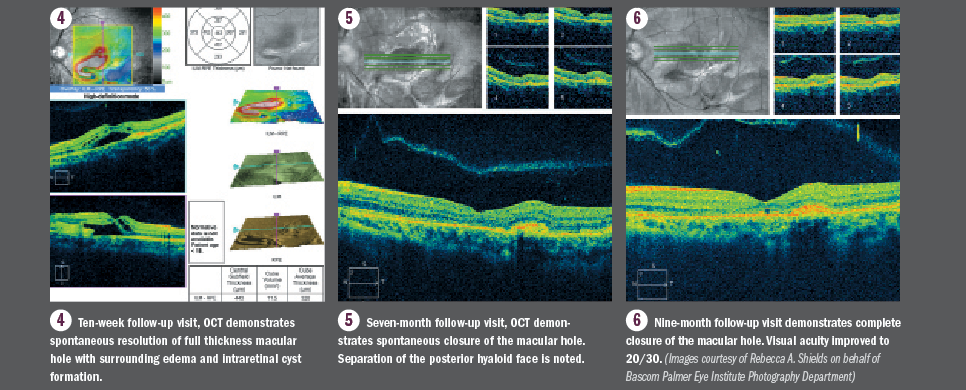Article
Boy presents with macular hole after trauma
A 12-year-old boy presents with full thickness macular hole 6 weeks after trauma to the left eye. What to do next?
Take home:
A 12-year-old boy presents with full thickness macular hole 6 weeks after trauma to the left eye. What to do next?
By Rebecca A. Shields, MD; Edited by Jonathan S. Chang, MD, and Aleksandra V. Rachitskaya, MD
A 12-year-old boy presented to the Bascom Palmer Eye Institute emergency room with blurry vision in his left eye after being hit in the left eye with a soda can at school. Review of symptoms was negative. The patient’s medical, surgical, and family histories were unremarkable.

Examination
On initial presentation, the patient’s best-corrected visual acuity (BCVA) was 20/20 in the right eye and 20/200 in the left eye. The pupils were pharmacologically dilated. IOP was 13 mm Hg in the right eye and 8 mm Hg in the left eye. Extraocular movements and confrontational fields were within normal limits. The exam of the right eye was within normal limits. The external examination of the left eye revealed periorbital edema and ecchymosis. Anterior segment examination revealed subconjunctival hemorrhage and microhyphema.
Posterior examination revealed extensive subretinal hemorrhage, choroidal rupture, commotio retinae, and vitreous hemorrhage (Figure 1).
No retinal tear or detachment was noted. The patient was started on topical prednisolone acetate and atropine. He was instructed to wear a shield and to abstain from physical activities. Orbital fracture was ruled out via computed tomography scan.
Optical coherence tomography (OCT) showed partial thickness macular hole, intraretinal thickening, and subretinal fluid (Figure 2).
The patient was followed closely with clinical exams and OCT imaging. Six weeks after the initial trauma, the patient was noted to have subjective blurring of central vision, best corrected visual acuity was 20/100.
OCT was obtained and showed full thickness macular hole and subretinal scar formation (Figures 3a, 3b). No vitreomacular traction was noted.
Diagnostic course
Upon the diagnosis of the full thickness macular hole at the 6-week follow-up, observational management was selected. The change in symptoms and previous OCT suggested the acute nature of the hole formation. At 10-week follow-up visit, the visual acuity improved to 20/60, and OCT began to demonstrate spontaneous resolution of the macular hole (Figure 4). Observation was continued.
At 7 months follow-up visit, the patient’s OCT demonstrated spontaneous closure of the macular hole with subretinal and intraretinal fluid (Figure 5). The separation of the posterior hyaloid was clearly seen.
At 9 months follow-up visit, BCVA was 20/30 in the left eye. OCT demonstrated an irregular foveal contour but now with complete closure of the macular hole (Figure 6).

Discussion
Traumatic macular holes were first described in the late 1800s. At that time, direct globe injury was believed to be the inciting event.
Modern theory remains unclear as to the specific mechanism of formation of traumatic macular holes. However, a number of hypotheses have been proposed.
Some researchers believe that tangential traction of the posterior hyaloid face may lead to development of holes. Others believe that sudden forces on the globe after blunt injury may place stress on the retina at points of vitreous attachment leading to traction and hole formation.
Recent studies in animals and surgical observation strongly support the belief that traction from the vitreous plays the largest role in hole formation. In spite of such discussion, a specific management algorithm has not yet been described and a complete understanding of the pathogenesis of disease has yet to be reported.
However, recent case reports of macular hole in the pediatric population often point to a traumatic etiology for disease development.
In previous reports, idiopathic macular holes have demonstrated great visual prognosis after vitrectomy surgery. A case series by Johnson, et al. in 2001 followed 25 cases of traumatic macular hole treated with vitrectomy.
However, in the study only one-third of these cases were pediatric cases. Twenty-four of the 25 cases had complete closure of the macular hole. In 84% of the cases, visual acuity improved 2 or more lines, with 64% of patients achieving vision of 20/50 or better.
Such a report is strong evidence for early surgical management to promote best visual prognosis. However, a number of other case series suggest observational management can be used in traumatic macular holes, as they often will spontaneously close without further intervention, thus sparing morbidity associated with surgical intervention.
Our patient improved significantly with observation alone. Studies suggest that spontaneous closure of traumatic holes occurs following resolution of vitreofoveal adhesion and release of the posterior hyaloid. Others argue that inflammatory mechanisms enable a reformation and spontaneous closure of the macular hole.
The exact mechanism of resolution is not clear in our patient, however, as reported in many articles. Pediatric patients for a number of reasons are more likely to experience spontaneous closure and good visual prognosis-further proving a role for observation in traumatic pediatric patients before embarking on surgical intervention and postoperative care that requires positioning.
Conclusion
Spontaneous closure of traumatic macular holes is a rarely reported event. Surgical intervention can be spared in a group of patients with hole formation after blunt trauma.
Clinical decision making, however, should be made on a case-by-case basis that considers the patient’s age, mechanism of trauma, potential for visual prognosis, and long-term morbidity associated with surgical intervention.
References
· Johnson RN, McDonald HR, Lewis H, et al. Traumatic macular hole: Observations, pathogenesis, and results of vitrectomy surgery. Ophthalmology. 2001;108:5:853–857.
· Yamada H, Sakai A, Yamada E, Nishimura T, Matsumura M. Spontaneous closure of traumatic macular hole. Am J Ophthalmol. 2002;134:340–347.
· Yamashita T, Uemara A, Uchino E, Doi N, Ohba N. Spontaneous closure of traumatic macular hole. Am J Ophthalmol. 2002;133:230–235.
Subscribe to Ophthalmology Times to receive the latest clinical news and updates for ophthalmologists.




